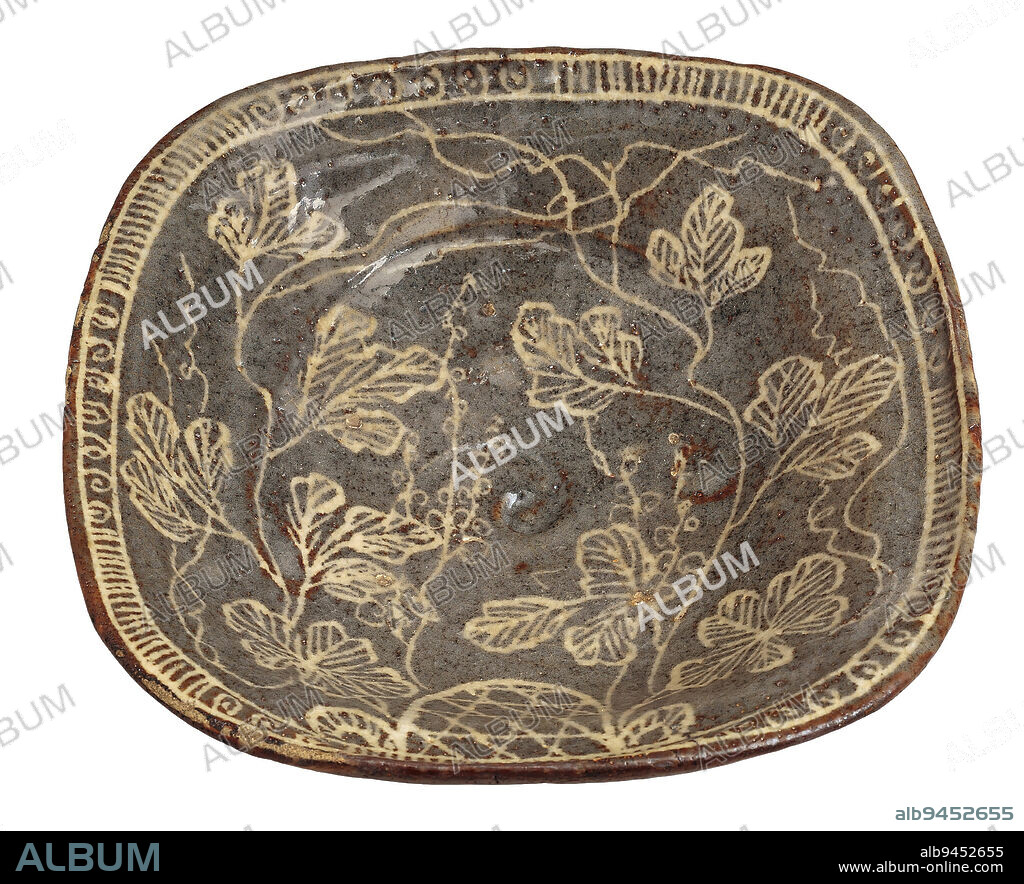alb9452655
Plate with grapevines, trellis, and geometric design, late 16th century, Unknown Japanese, 2 3/4 × 11 3/16 × 10 9/16 in. (6.99 × 28.42 × 26.83 cm), Mino ware, Nezumi-Shino type; stoneware with underglaze iron oxide, Japan, 16th century, Mino ware, Nezumi Shino type; Formal tea gatherings are accompanied by kaiseki, multicourse communal meals at which dishes would be served on plates like this one, which was created by a potter in the Mino region of central Japan. Mino potters in the late 1500s produced a wide variety of innovative ceramic styles in quick succession, with each style swiftly arousing interest, but then just as quickly dying outwares that included the now celebrated Black Seto, Yellow Seto, Oribe, and Shino styles. This plate represents a substyle of Shino ware known as Nezumi, or 'mouse-gray' Shino. Potters created these wares by applying a coat of iron-rich slip (liquid clay) to the formed vessel, allowing it to dry, and then using a sharp tool to etch a design into the coating, revealing the white clay below. This and other Mino vessels from the late 1500s were fired in partially underground kilns known as an gama.

|
Añadir a otro lightbox |
|
Añadir a otro lightbox |



¿Ya tienes cuenta? Iniciar sesión
¿No tienes cuenta? Regístrate
Compra esta imagen.
Selecciona el uso:

Descripción:
Ver traducción automática
Plate with grapevines, trellis, and geometric design, late 16th century, Unknown Japanese, 2 3/4 × 11 3/16 × 10 9/16 in. (6.99 × 28.42 × 26.83 cm), Mino ware, Nezumi-Shino type; stoneware with underglaze iron oxide, Japan, 16th century, Mino ware, Nezumi Shino type; Formal tea gatherings are accompanied by kaiseki, multicourse communal meals at which dishes would be served on plates like this one, which was created by a potter in the Mino region of central Japan. Mino potters in the late 1500s produced a wide variety of innovative ceramic styles in quick succession, with each style swiftly arousing interest, but then just as quickly dying outwares that included the now celebrated Black Seto, Yellow Seto, Oribe, and Shino styles. This plate represents a substyle of Shino ware known as Nezumi, or 'mouse-gray' Shino. Potters created these wares by applying a coat of iron-rich slip (liquid clay) to the formed vessel, allowing it to dry, and then using a sharp tool to etch a design into the coating, revealing the white clay below. This and other Mino vessels from the late 1500s were fired in partially underground kilns known as an gama.
Personas:
Crédito:
Album / quintlox
Autorizaciones:
Tamaño imagen:
3317 x 2691 px | 25.5 MB
Tamaño impresión:
28.1 x 22.8 cm | 11.1 x 9.0 in (300 dpi)
Palabras clave:
ABRIGO • APLICACION • BARRO BLANCO • DISEÑO • DISPARARON • ETCH • GRES • JAPON • PLACAS • PLATO • PLATOS • REVESTIMIENTO • S. XVI • SECO • SIGLO XVI • UNKNOWN JAPANESE


 Pinterest
Pinterest Twitter
Twitter Facebook
Facebook Copiar enlace
Copiar enlace Email
Email
